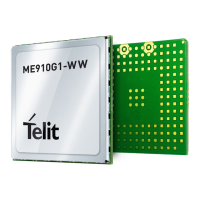PCB Design Guidelines
When using the ME910G1, as there is no antenna connector on the module, the antenna
must be connected to the ME910G1 antenna pad (K1) by means of a transmission line
implemented on the PCB.
This transmission line shall fulfil the following requirements:
Table 29: ME910G1 Antenna pad requirements
The transmission line should be designed according to the following guidelines:
• Make sure that the characteristic impedance of the transmission line is 50 ohm;
• Keep the line on the PCB as short as possible, as the loss of the antenna line
should be less than about 0,3 dB;
• The line geometry should have uniform characteristics, constant cross section,
avoid meanders and sharp curves;
• Any type of suitable geometry / structure (Microstrip, Stripline, Coplanar,
Grounded Coplanar Waveguide...) can be used to implement the printed
transmission line afferent to the antenna;
• If a Ground plane is required in line geometry, that plane shall be continuous and
sufficiently extended, so that the geometry can be as similar as possible to the
related canonical model;
• Keep, if possible, at least one layer of the PCB used only for the Ground plane; If
possible, use this layer as a reference Ground plane for the transmission line;
• It is advisable to surround (on both sides) the transmission line of the PCB with
Ground, avoiding that other signal tracks face directly the antenna line track.
• Avoid crossing any un-shielded transmission line footprint with other signal tracks
on different layers;
The ground surrounding the antenna line on PCB shall be strictly connected to the
main Ground Plane by means of via holes (once per 2mm at least), positioned near
the ground edges facing the line track;

